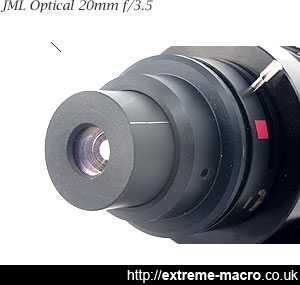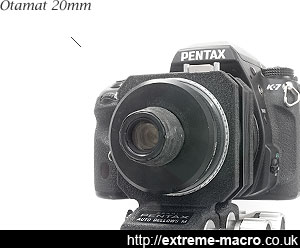Other Extreme Macro Lenses
by Johan J Ingles-Le Nobel
Last updated August 31, 2017
Very few camera manufacturers take extreme macro photography seriously, which means we have to be creative.
Extreme macro lenses come from in all shapes and sizes, with different optics being repurposed for extreme macro on a continuous basis.
JML Optical 21mm f/3.5, an outstanding optic for extreme macro.
The Image Circle and You
Whilst we're trying to be creative and looking for great optics to use for extreme macro, there's a complication that must be taken into consideration from the outset, namely your image circle. The image circle of a lens is the area over which the image is good.
For full frame a lens must have an image circle larger than 43.27mm, and for a 15 x 22.5 mm APSC frame, an image circle of at least 27.04mm.
This complicates matters looking for an extreme macro lens because a lens might produce great quality but the image circle is too small to use. The flipside is that cameras with smaller sensors will enjoy a wider choice than APSC or fullframe.
20mm microfilm lens, mounted using a spare objective adapter. Finding an adapter for an unusual optic can be problematic, so I used a double sided rubber tape from the motor industry round the lens, which allowed it to be screwed into the adapter nicely.
Microfilm Lenses
Back in the day, a microfilm reader was a device used for reading of documents stored as microform. Microform includes flat film, microfilm, aperture cards, microfiche, and ultra fiche - all ways to store documents in a small space.
A microfilm reader is used in projecting and viewing to magnify tiny microfilm images to readable proportions: microfilm reader lenses are therefore interesting.
Good photography lenses out there have lp/mm values of a bit over 100, but microfilm reader lenses can go up to 400 lp/mm. Microfilm reader lenses are therefore an obvious avenue to pursue in the quest for a budget price, high resolving high magnification optic.
Cine Lenses
H. Lou Gibson reports that a reversed 25mm f/1.9 Cine Ektar II works very well at high magnificationsAlthough I have not used these myself, allegedly cine lenses work well extreme macro. I have seen the following in use: 20mm Zuiko, 13mm Cine Nikkor, Cine Ektar II, Macro Switar & Kern. The cine lenses have to be reversed to work properly for extreme macro. In the Kodak Publication N-12B "Photomacrography" H. Lou Gibson reports that a reversed 25mm f/1.9 Cine Ektar II works very well at high magnifications. According to online tests, a reversed 25mm f/1.9 Cine Ektar II shows a better performance than a 25mm f/3.5 Luminar, when set at f/2.8, between 10:1 and 20:1 magnifications.
This should not be too surprising. After all, cine lenses are made with the intent that the image is going to be blown up for projection a lot more than camera lenses, so they have to have some oomph. In terms of their use, be aware that cine lenses are often engraved in t/stops rather than f/stops. Whilst an f/stop is the mathematical representation of what the design is supposed to be delivering in terms of light transmission, a t/stop is determined by actual measurement, so it is more of a real world representation.
CCTV Lenses
The vast majority of cameras used in security that are already in place are standard NTSC cameras, 640 x 480 pixels. Resolution is therefore not a priority, and CCTV lenses are currently not recommended for extreme macro.
CCTV lenses are currently not recommended for extreme macro. No doubt this will change over timeNo doubt this will change over time, but in the testing I've seen of CCTV lenses used for extreme macro the results were very poor. This is obviously a bit disappointing with cheap CCTV lenses are flooding eBay. But they're cheap for a reason and this technology can only be expected to improve.
Industrial Lenses
Numerous optical techniques are used throughout industry and are critical to the manufacture of such diverse and basic products as semiconductor chips, roads, tunnels, and chemicals. These are high quality optics that the average photographer will not come into contact with undoubtedly contain very interesting optics for extreme macro.
Sometimes surplus industrial optics do become available, and one example of this is the JML Optical 21mm f/3.5Information technology, telecommunications, healthcare, life sciences, security, defence, industrial manufacturing: each of these sectors has bespoke optical requirements and there is a network of specialised optics providers that caters for these making optics that could very well be repurposed for extreme macro. However, these optics, being low production units, tend to be extremely expensive and out of the budget of all except the most enthusiastic of extreme macro photographers.
Sometimes surplus industrial optics do become available, and one example of this is the JML Optical 21mm f/3.5 of which a consignment became available in 2010. This lens was quickly picked up by the extreme macro crowd and from its original surplus price listing of $5 on eBay, it now trades hands between macro enthusiasts at prices in the region of $400 US. This is a wide-field, high-resolution optic, in the same league as the Photar 25mm f/2 and the Mitutoyo 5x NA 0.14, and is better than the Olympus 38mm f/2.8.
Other Lens Avenues
There really is no reason to stick to the usual lenses in the quest for extreme macro. For example, eyepiece optics can also be used, which although they may not give you the pixel peeping resolution that the best optics will provide, will nevertheless give many hours of entertainment and could help you decide if extreme macro is for you. Do beware though, that adapters may be tricky to find for unusually repurposed optics.
Canon Mp-e 65
The Canon Mp-e 65 is the only consumer lens that can be zoomed between 1:1 and 5:1. However, this is a Canon-mount lens, and cannot be fitted to other mounts, which is obviously problematic if you do not use Canon! There are various approaches to duplicating the Mp-e65, one such approach is mine, dubbed the Mp-e 64.
Related Articles






